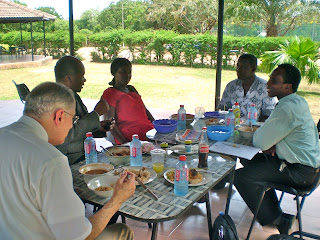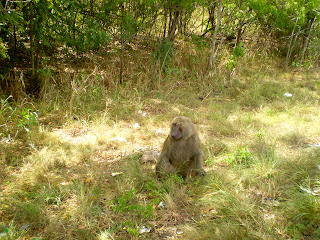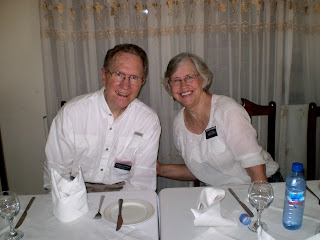

There are traditional dishes from each ethnic group, tribe and clan. The main dishes are organized around a starchy staple such as rice, fufu, banku, kenkey, etc. each in a sauce or soup saturated with fish, meat or mushrooms.
In the south, where we live, the staples include cassava and plantain. Yam, maize and beans are used as staple foods also.
Fufu is boiled cassava and plantain or yam and plantain pounded with a large mortar and pestle, (made of wood), into a round, pulped, gooey ball.
Banku is cooked fermented corn and cassava dough. (below) It has the consistency of cheese. Not our favorite!
Kenkey is fermented corn dough wrapped in corn or plantain leaves and cooked into a consistent solid ball.
Most of the meetings in Ghana, like the faculty meeting at the above right, serve food. Sometimes breakfast, sometimes lunch, and sometimes just a "snack". We even had food after the graduation we attended! Ghanaian food is often very spicy. Because it is a starch based experience, the spices keep it from tasting bland. Above is "light" soup with goat. There is nothing light about it. It is very spicy and most often eaten with fufu.
Below are beans and rice (often served with chicken or goat). The other night we went to a restaurant with some friends from the US. They had a lovely buffet of African food and drummers and dancers. One of our party, the white guy below in the striped shirt jumped right in and helped with the show. He has a PhD in music and had a great time.
 Most Ghanaian dishes are served with a stew or soup with a wide variety of flavors, spices and textures. Common soups are groundnut soup (peanut), light (tomato and very spicy) soup, Tomato stew or gravy is a stew which is often very thick and served with rice. The soups often have meat, mainly goat, sometimes chicken. Fish is quite popular, either smoked or fried, but we do not buy locally because of where they catch it. Fried plantains are also popular.
Most Ghanaian dishes are served with a stew or soup with a wide variety of flavors, spices and textures. Common soups are groundnut soup (peanut), light (tomato and very spicy) soup, Tomato stew or gravy is a stew which is often very thick and served with rice. The soups often have meat, mainly goat, sometimes chicken. Fish is quite popular, either smoked or fried, but we do not buy locally because of where they catch it. Fried plantains are also popular.Because meat is so expensive we often eat eggs for protein. The chicken we do buy is often quite tough, and sometimes we buy minced meat (hamburger) if we are in a store we trust.
To the right is a typical dinner for us at home. (omelet)
Below is a breakfast we had at a meeting. The Ghanaians make great oatmeal cereal and these little meat pies that are really good. The juice is wonderful and usually sold in boxes off the shelf, as is the milk. (It is preserved through a heating process)
 Often you will see outside cafes where food is served on the street. Dishwashing included.
Often you will see outside cafes where food is served on the street. Dishwashing included. We only drink bottled water from the stores. If you buy it off the street, the risk is that the bottle was refilled by the vendors. Many of the Ghanaians buy their water in plastic packets, bite off the corner and then squeeze the water into their mouth (like the little one below).
Food is very expensive here. $15 for a box of Raisin Bran, $4 for a small can of peaches, $9 for a chunk of cheddar cheese the size of a stack of playing cards, and $6 for a med. bag of M & M's. So...obviously we are not eating those things!
This was a meeting we were in with the Vice Chancellor who is the President of the University of Ghana. Eating again.
Here the senior missionaries are watching a live broadcast of our own Area President, Elder Dickson, speaking in General Conference in Salt Lake City. We were watching the Sat. afternoon session at 2:00 pm from 8-10 pm our time, but were thrilled to get it. The very next Sunday Elder Dickson was back in our chapel here in Accra speaking and encouraging 40 humble saints in the Jamestown Branch. In 2012 the Africa West Area accounted for 33% of the entire growth of the Church in wards and branches, and 14% of the growth in new Stakes. Amazing!
We watched conference in the upstairs conference room at the Area Office building where this week we gave the senior missionaries and temple staff free hearing tests...50 of them! Long day for Elder Ribera.


























